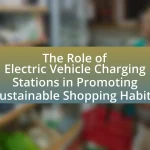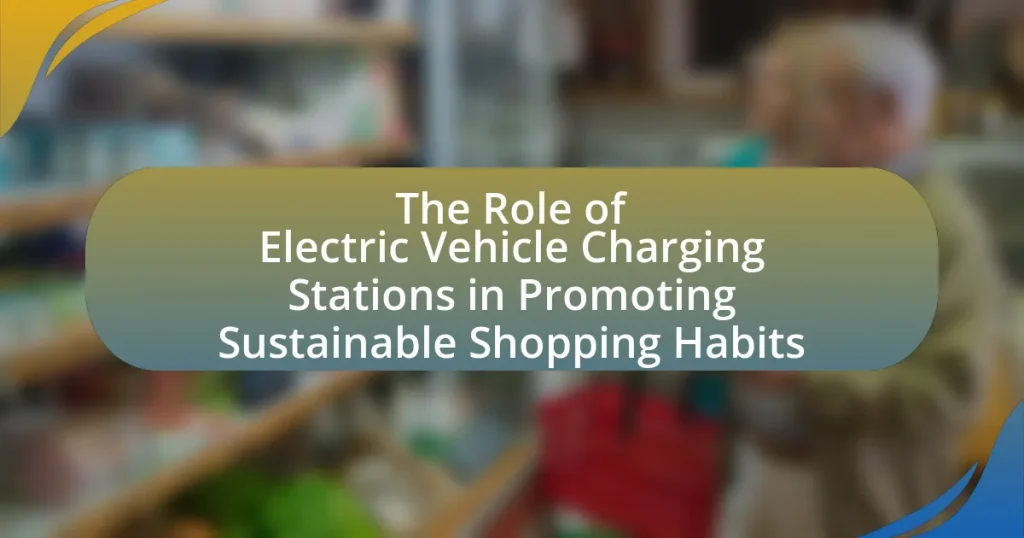Electric vehicle charging stations are essential in promoting sustainable shopping habits by providing accessible charging infrastructure that encourages the use of electric vehicles (EVs). The article explores how the availability of charging stations influences consumer behavior, increases shopping frequency, and enhances the overall shopping experience. It discusses the environmental benefits of charging stations, including reduced greenhouse gas emissions and improved air quality, while also examining the types of charging stations available and their integration into retail environments. Additionally, the article addresses the challenges retailers face in implementing charging stations, the role of government policies, and future trends in charging technology that support sustainable consumer practices.
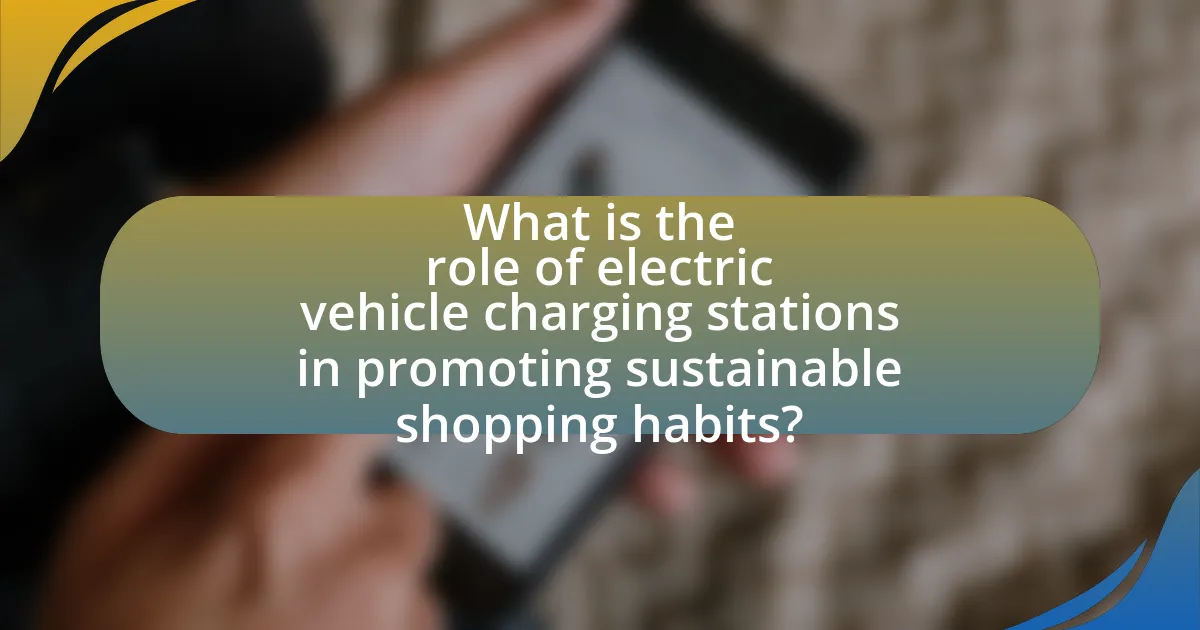
What is the role of electric vehicle charging stations in promoting sustainable shopping habits?
Electric vehicle charging stations play a crucial role in promoting sustainable shopping habits by providing convenient access to charging infrastructure that encourages consumers to choose electric vehicles for their shopping trips. This accessibility reduces reliance on fossil fuel-powered vehicles, thereby lowering greenhouse gas emissions associated with shopping-related travel. According to a study by the International Council on Clean Transportation, increased availability of charging stations correlates with higher adoption rates of electric vehicles, which in turn supports sustainable consumer behavior. By integrating charging stations into shopping areas, retailers can attract eco-conscious customers, enhance their brand image, and contribute to a more sustainable retail environment.
How do electric vehicle charging stations influence consumer behavior?
Electric vehicle charging stations significantly influence consumer behavior by increasing the likelihood of electric vehicle adoption and usage. Research indicates that the availability of charging infrastructure directly correlates with consumer confidence in electric vehicles, as 80% of potential buyers consider charging accessibility a critical factor in their purchasing decision. Furthermore, the presence of charging stations in retail locations encourages consumers to shop longer and spend more, as they can charge their vehicles while engaging in other activities. This behavior is supported by a study from the International Council on Clean Transportation, which found that consumers are more likely to visit stores with charging stations, leading to increased foot traffic and sales for those businesses.
What factors motivate shoppers to choose locations with charging stations?
Shoppers are motivated to choose locations with charging stations primarily due to the convenience and accessibility of charging their electric vehicles while shopping. This convenience allows them to combine errands with charging needs, reducing the time and effort required to find a charging station elsewhere. Additionally, the presence of charging stations can enhance the overall shopping experience, as consumers often prefer locations that cater to their electric vehicle needs. Research indicates that 70% of electric vehicle owners consider the availability of charging stations a critical factor in their shopping decisions, highlighting the importance of infrastructure in influencing consumer behavior.
How does the availability of charging stations affect shopping frequency?
The availability of charging stations positively affects shopping frequency by increasing the convenience for electric vehicle (EV) owners. When charging stations are readily accessible, EV owners are more likely to visit shopping locations, as they can charge their vehicles while they shop. A study by the International Council on Clean Transportation found that the presence of charging infrastructure can lead to a 20% increase in shopping visits among EV users. This correlation indicates that the convenience of charging stations directly influences consumer behavior, encouraging more frequent shopping trips.
Why are electric vehicle charging stations important for sustainability?
Electric vehicle charging stations are crucial for sustainability because they facilitate the transition from fossil fuel-powered vehicles to electric vehicles, which produce lower greenhouse gas emissions. The availability of charging infrastructure encourages more consumers to adopt electric vehicles, thereby reducing reliance on gasoline and diesel, which contribute significantly to air pollution and climate change. According to the International Energy Agency, electric vehicles can reduce carbon emissions by up to 70% compared to conventional vehicles when charged with renewable energy sources. This shift not only helps in mitigating environmental impacts but also promotes the use of clean energy, further enhancing sustainability efforts.
What environmental benefits do electric vehicle charging stations provide?
Electric vehicle charging stations provide significant environmental benefits by reducing greenhouse gas emissions and promoting the use of renewable energy sources. The transition to electric vehicles (EVs) decreases reliance on fossil fuels, which are major contributors to air pollution and climate change. According to the U.S. Department of Energy, electric vehicles produce zero tailpipe emissions, leading to improved air quality in urban areas. Furthermore, when charging stations are powered by renewable energy, such as solar or wind, the overall carbon footprint of transportation is further minimized, supporting sustainability efforts. This shift not only helps mitigate climate change but also fosters a cleaner environment for future generations.
How do charging stations contribute to reducing carbon footprints?
Charging stations contribute to reducing carbon footprints by facilitating the use of electric vehicles (EVs), which produce zero tailpipe emissions. The transition from gasoline-powered vehicles to EVs significantly lowers greenhouse gas emissions, as studies indicate that EVs can reduce carbon emissions by up to 70% when charged with renewable energy sources. Furthermore, the availability of charging stations encourages more consumers to adopt electric vehicles, thereby increasing the overall reduction in fossil fuel dependency and promoting cleaner air quality.
What types of electric vehicle charging stations are available for shoppers?
There are three main types of electric vehicle charging stations available for shoppers: Level 1, Level 2, and DC Fast Charging stations. Level 1 charging stations use a standard 120-volt outlet and are typically found in residential areas, providing a slow charge suitable for overnight charging. Level 2 charging stations operate on a 240-volt supply and are commonly located in public spaces, offering a faster charging option that can replenish an electric vehicle’s battery in a few hours. DC Fast Charging stations provide rapid charging capabilities, allowing shoppers to charge their vehicles to 80% in approximately 30 minutes, making them ideal for quick stops during shopping trips. These charging options support the growing demand for electric vehicles and facilitate sustainable shopping habits by providing convenient access to charging infrastructure.
What are the differences between Level 1, Level 2, and DC fast charging stations?
Level 1, Level 2, and DC fast charging stations differ primarily in their charging speed and power output. Level 1 charging stations provide 120 volts and typically deliver 2 to 5 miles of range per hour, making them suitable for home use where vehicles can charge overnight. Level 2 charging stations operate at 240 volts and can provide 10 to 60 miles of range per hour, commonly found in public charging locations and workplaces, allowing for quicker charging during shorter stops. DC fast charging stations, on the other hand, utilize direct current and can deliver 60 to 350 kW, enabling rapid charging that can add 100 miles of range in approximately 30 minutes, making them ideal for long-distance travel. These differences in voltage and charging speed cater to various user needs and charging scenarios, promoting the adoption of electric vehicles.
How do different charging station types cater to various shopping environments?
Different charging station types cater to various shopping environments by providing tailored solutions that enhance convenience and accessibility for electric vehicle users. For instance, fast charging stations are typically located in high-traffic retail areas, allowing shoppers to quickly recharge their vehicles while they shop, thus minimizing downtime. In contrast, Level 2 charging stations are often found in parking lots of grocery stores or shopping malls, where customers can plug in their vehicles for a longer duration while they complete their shopping, promoting a more leisurely shopping experience. Additionally, destination charging stations at hotels or restaurants encourage longer visits, as they provide a charging option while customers enjoy their stay or meal. This strategic placement of charging stations aligns with consumer behavior, as studies show that 70% of EV owners prefer to charge their vehicles at locations where they spend time, reinforcing the importance of integrating charging infrastructure into shopping environments.
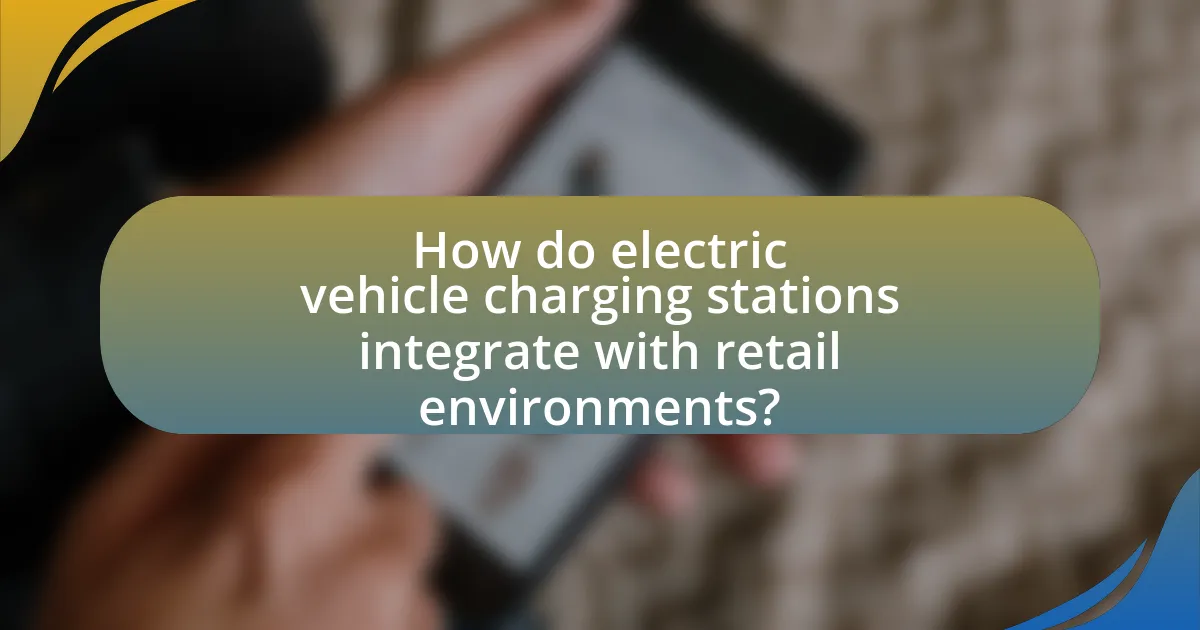
How do electric vehicle charging stations integrate with retail environments?
Electric vehicle charging stations integrate with retail environments by providing convenient charging options that encourage customers to shop while their vehicles are charging. Retailers install these stations to attract eco-conscious consumers, enhance customer experience, and increase dwell time, which can lead to higher sales. For instance, a study by the International Council on Clean Transportation found that 70% of EV owners prefer to charge their vehicles at retail locations, indicating a strong consumer preference for integrated charging solutions. This integration not only supports sustainable shopping habits but also aligns with retailers’ goals to promote environmentally friendly practices and attract a growing market of electric vehicle users.
What strategies do retailers use to incorporate charging stations?
Retailers incorporate charging stations by strategically placing them in high-traffic areas, enhancing customer convenience and encouraging longer shopping durations. This placement often aligns with the store’s layout, ensuring visibility and accessibility. Additionally, retailers partner with charging network providers to offer fast-charging options, which attract electric vehicle owners. For instance, major retailers like Walmart and Target have installed charging stations to not only serve customers but also to promote sustainability, reflecting a commitment to eco-friendly practices. This approach is supported by data showing that 70% of EV owners prefer charging while shopping, thus increasing foot traffic and sales.
How can retailers enhance customer experience through charging station placement?
Retailers can enhance customer experience through strategic placement of charging stations by ensuring they are easily accessible and located in high-traffic areas. This convenience encourages customers to spend more time in-store while their vehicles charge, leading to increased foot traffic and potential sales. Research indicates that 70% of electric vehicle owners prefer shopping at locations with charging stations, as it aligns with their sustainable lifestyle choices. By integrating charging stations into the shopping environment, retailers not only meet customer needs but also promote a commitment to sustainability, enhancing brand loyalty and customer satisfaction.
What partnerships can retailers form to install charging stations?
Retailers can form partnerships with electric vehicle (EV) charging network providers, local governments, and renewable energy companies to install charging stations. Collaborating with EV charging network providers, such as ChargePoint or EVgo, allows retailers to leverage existing infrastructure and expertise in charging technology. Partnering with local governments can facilitate access to grants or incentives aimed at promoting sustainable transportation initiatives. Additionally, working with renewable energy companies can ensure that the electricity used for charging stations is sourced from sustainable energy, enhancing the retailer’s commitment to sustainability. These partnerships not only improve customer convenience but also align with the growing demand for eco-friendly shopping options.
How do charging stations impact the overall shopping experience?
Charging stations significantly enhance the overall shopping experience by providing convenience and encouraging longer visits. When shoppers have access to charging stations, they can recharge their electric vehicles while shopping, which reduces range anxiety and allows them to spend more time at retail locations. A study by the International Council on Clean Transportation found that the availability of charging infrastructure can increase foot traffic by up to 20%, as consumers are more likely to choose shopping destinations that accommodate their electric vehicle needs. This increased foot traffic often translates into higher sales for retailers, demonstrating that charging stations not only support sustainable transportation but also positively influence consumer behavior and retail performance.
What amenities can be offered near charging stations to attract shoppers?
Amenities that can be offered near charging stations to attract shoppers include cafes, seating areas, free Wi-Fi, restrooms, and retail shops. These amenities enhance the shopping experience by providing comfort and convenience while customers wait for their electric vehicles to charge. For instance, studies show that locations with food and beverage options see increased foot traffic, as shoppers are more likely to spend time and money in areas where they can relax and enjoy refreshments. Additionally, providing free Wi-Fi encourages customers to browse online or engage with social media, further increasing their time spent at the location.
How does the presence of charging stations influence store loyalty?
The presence of charging stations significantly enhances store loyalty by providing convenience and attracting electric vehicle (EV) owners. Research indicates that 70% of EV owners prefer shopping at locations with charging infrastructure, as it allows them to charge their vehicles while they shop, thus increasing the likelihood of repeat visits. Additionally, stores that offer charging stations often see a boost in foot traffic, as EV owners are more inclined to choose these locations over competitors without such amenities. This correlation between charging station availability and customer retention underscores the importance of integrating EV infrastructure into retail strategies to foster sustainable shopping habits.
What challenges do retailers face when implementing charging stations?
Retailers face several challenges when implementing charging stations, including high installation costs, limited space, and regulatory compliance. The initial investment for purchasing and installing charging infrastructure can be significant, often ranging from $2,000 to $50,000 per station, depending on the type and capacity. Additionally, many retailers struggle with finding adequate space to install these stations, especially in urban areas where real estate is limited. Furthermore, compliance with local regulations and permitting processes can be complex and time-consuming, potentially delaying the implementation of charging stations. These challenges can hinder retailers’ ability to provide convenient charging options for electric vehicle users, impacting their overall sustainability goals.
What are the costs associated with installing electric vehicle charging stations?
The costs associated with installing electric vehicle charging stations typically range from $2,000 to $50,000, depending on various factors such as the type of charger, installation complexity, and location. Level 2 chargers, which are commonly used for residential and commercial installations, generally cost between $2,000 and $7,500, including equipment and installation. Fast chargers, which are more expensive and suitable for public charging stations, can cost between $15,000 and $50,000, with additional costs for electrical upgrades and site preparation. According to the U.S. Department of Energy, the average installation cost for a Level 2 charger is around $4,500, which includes both hardware and labor.
How can retailers overcome regulatory hurdles related to charging station installation?
Retailers can overcome regulatory hurdles related to charging station installation by engaging with local government agencies early in the planning process. This proactive approach allows retailers to understand specific regulations, zoning laws, and permitting requirements that may affect installation. For instance, according to the U.S. Department of Energy, many municipalities have streamlined permitting processes for electric vehicle charging stations, which can significantly reduce installation time and costs. Additionally, retailers can collaborate with industry associations that advocate for favorable policies and provide resources to navigate regulatory landscapes effectively.
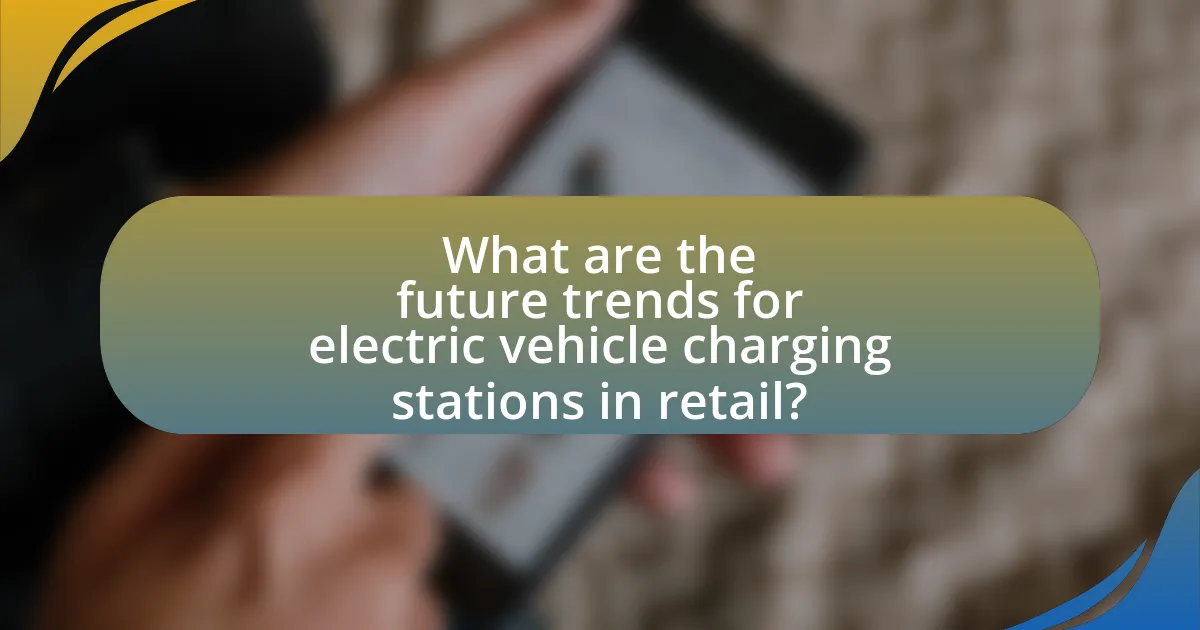
What are the future trends for electric vehicle charging stations in retail?
Future trends for electric vehicle charging stations in retail include the integration of fast-charging technology, increased installation of charging infrastructure, and the development of smart charging solutions. Fast-charging technology is expected to reduce charging times significantly, making it more convenient for consumers to charge their vehicles while shopping. Retailers are increasingly investing in charging infrastructure, with a report from the International Energy Agency indicating that the number of public charging points worldwide reached over 1.3 million in 2020, and this number is projected to grow as demand for electric vehicles rises. Additionally, smart charging solutions that utilize data analytics and mobile applications will enhance user experience by allowing customers to locate available charging stations, reserve spots, and manage charging times efficiently. These trends collectively support the promotion of sustainable shopping habits by encouraging the use of electric vehicles.
How is technology evolving in electric vehicle charging solutions?
Technology in electric vehicle charging solutions is evolving through advancements in fast charging, wireless charging, and smart grid integration. Fast charging technology has significantly reduced charging times, with some stations now capable of delivering up to 350 kW, allowing for an 80% charge in under 30 minutes. Wireless charging systems are being developed to eliminate the need for physical connections, enhancing convenience and usability. Additionally, smart grid integration enables real-time monitoring and management of energy consumption, optimizing charging schedules based on grid demand and renewable energy availability. These advancements support the growing adoption of electric vehicles and contribute to sustainable shopping habits by making charging more accessible and efficient.
What innovations are being developed to improve charging station efficiency?
Innovations being developed to improve charging station efficiency include ultra-fast charging technology, smart grid integration, and wireless charging systems. Ultra-fast charging technology, such as 350 kW chargers, significantly reduces charging time, allowing electric vehicles to recharge in under 15 minutes. Smart grid integration enables real-time energy management, optimizing energy distribution based on demand and reducing peak load stress on the grid. Wireless charging systems, utilizing inductive charging pads, eliminate the need for physical connectors, enhancing user convenience and potentially increasing charging station usage. These advancements collectively contribute to a more efficient and user-friendly charging infrastructure, promoting the adoption of electric vehicles.
How might smart charging stations change the shopping landscape?
Smart charging stations will transform the shopping landscape by integrating electric vehicle (EV) charging with retail experiences, encouraging longer shopping durations. As consumers charge their vehicles, they are likely to spend more time in nearby stores, leading to increased foot traffic and sales for retailers. Research indicates that locations with charging stations can see a 20% increase in customer dwell time, which directly correlates with higher spending. Additionally, smart charging stations can offer targeted promotions and discounts to EV users, further incentivizing shopping at specific locations. This synergy between charging infrastructure and retail not only supports sustainable shopping habits but also enhances the overall consumer experience.
What role do government policies play in the expansion of charging stations?
Government policies significantly influence the expansion of charging stations by providing funding, incentives, and regulatory frameworks that encourage infrastructure development. For instance, policies such as tax credits for installation and grants for local governments facilitate the financial feasibility of deploying charging stations. According to the U.S. Department of Energy, federal and state initiatives have led to a substantial increase in charging infrastructure, with over 100,000 public charging outlets available as of 2023. These policies not only stimulate private investment but also ensure that charging stations are strategically located to meet the growing demand for electric vehicles, thereby promoting sustainable shopping habits.
What incentives are available for retailers to install charging stations?
Retailers can access various incentives to install charging stations, including federal tax credits, state grants, and utility rebates. The federal government offers a tax credit of up to 30% of the cost of purchasing and installing electric vehicle charging equipment, capped at $1,000 for residential and $30,000 for commercial installations. Additionally, many states provide grants or low-interest loans to support the installation of charging infrastructure, with some states like California offering up to $70,000 for public charging stations. Utility companies often have rebate programs that can cover a portion of the installation costs, further reducing the financial burden on retailers. These incentives not only lower the initial investment but also enhance customer attraction and retention by promoting sustainable shopping habits.
How do local regulations impact the deployment of charging infrastructure?
Local regulations significantly influence the deployment of charging infrastructure by establishing guidelines for installation, permitting processes, and operational standards. These regulations can either facilitate or hinder the development of charging stations, depending on their complexity and stringency. For instance, municipalities with streamlined permitting processes and incentives for installation can accelerate the growth of charging networks, while those with restrictive zoning laws or high compliance costs may deter investment. According to a report by the International Council on Clean Transportation, regions that implement supportive policies, such as tax credits and grants for charging infrastructure, see a higher density of charging stations, which correlates with increased electric vehicle adoption.
What best practices should retailers follow when implementing charging stations?
Retailers should prioritize strategic placement, user-friendly technology, and clear signage when implementing charging stations. Strategic placement ensures that charging stations are located in high-traffic areas, maximizing visibility and accessibility for customers. User-friendly technology, such as fast chargers and compatibility with various electric vehicle models, enhances the customer experience and encourages usage. Clear signage is essential for guiding customers to the charging stations and providing information on usage, costs, and availability. According to a study by the International Council on Clean Transportation, well-placed and accessible charging infrastructure significantly increases electric vehicle adoption, demonstrating the importance of these best practices in promoting sustainable shopping habits.
How can retailers effectively market their charging station offerings to consumers?
Retailers can effectively market their charging station offerings to consumers by highlighting the convenience and sustainability benefits of electric vehicle charging. By promoting the availability of charging stations as a value-added service, retailers can attract eco-conscious customers who prioritize sustainable shopping habits. For instance, studies show that 70% of electric vehicle owners prefer shopping at locations with charging stations, indicating a strong consumer preference for convenience and sustainability. Additionally, retailers can utilize targeted advertising, social media campaigns, and in-store signage to raise awareness about their charging infrastructure, thereby enhancing customer engagement and driving foot traffic.
What considerations should be made for the maintenance of charging stations?
Regular maintenance of charging stations is essential to ensure their reliability and efficiency. Key considerations include routine inspections to check for wear and tear, software updates to enhance functionality, and cleaning to prevent debris buildup that could obstruct access or damage equipment. Additionally, monitoring the electrical systems for faults and ensuring compliance with safety standards are critical to prevent hazards. According to the U.S. Department of Energy, proper maintenance can extend the lifespan of charging stations and improve user satisfaction, thereby promoting the adoption of electric vehicles and supporting sustainable shopping habits.






